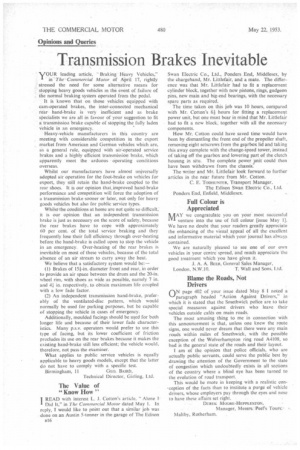Transmission Brakes Inevitable
Page 50

If you've noticed an error in this article please click here to report it so we can fix it.
YOUR leading article, "' Braking Heavy Vehicles," in The Commercial Motor of April 17, rightly stressed the need for some alternative means for stopping heavy goods vehicles in the event of failure of the normal braking system operated from the pedal. It is known that on those vehicles equipped with cam-operated brakes, the inter-connected mechanical rear hand-brake is very inefficient and as brake specialists we are all in favour of your suggestion to fit a transmission brake capable of stopping the fully laden vehicle in an emergency. Heavy-vehicle manufacturers in this country are meeting with considerable competition in the export market from American and German vehicles which are, as a general rule, equipped with air-operated service brakes and a highly efficient transmission brake, which apparently meet the arduous operating conditions overseas.
Whilst our manufacturers have almost universally adopted air operation for the foot-brake on vehicles for export, they still retain the hand-brake coupled to the rear shoes. It is our opinion that,improved hand-brake performance and competition will force the adoption of a transmission brake sooner or later, not only for heavy goods vehicles but also for public service types.
Whilst-the conditions at home are not quite so difficult, it is our opinion that an independent transmission brake is just as necessary on the score of safety, because the rear brakes have to cope with approximately 60 per cent. of the total service braking and they frequently lose their full efficiency through over-heating before the hand-brake is called upon to stop the vehicle in an emergency. Over-heating of the rear brakes is inevitable on most of these vehicles, because of the total absence of an air stream to carry away the heat.
We believe that a satisfactory system would be:—
(1) Brakes of 15i-in. diameter front and rear, in order to provide an air space between the drum and the 20-in. wheel rim, with shoes as wide as possible, namely 7 in. and 44 in. respectively, to obtain maximum life coupled with a low fade factor.
(2) An independent transmission hand-brake, preferably of the ventilated-disc pattern, which would normally be used for parking purposes, but be capable of stopping the vehicle in cases of emergency. Additionally, moulded facings should be used for both longer life and because of their lower fade characteristics. Many p.s.v. operators would prefer to use this type of facing, but its lower coefficient of friction precludes its use on the rear brakes because it makes the existing hand-brake still less efficient; the vehicle would, therefore, not pass the examiner. What applies to public service vehicles is equally applicable to heavy goods models, except that the latter do not have to comply with a specific test.
Birmingham, 11 GEO. Baud),
Technical Director, Girling, Ltd.




















































































